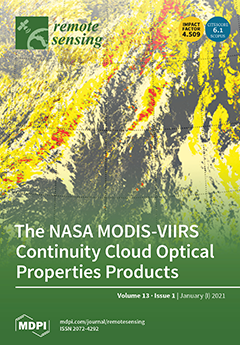Maize is a widely grown crop in China, and the relationships between agroclimatic parameters and maize yield are complicated, hence, accurate and timely yield prediction is challenging. Here, climate, satellite data, and meteorological indices were integrated to predict maize yield at the city-level
[...] Read more.
Maize is a widely grown crop in China, and the relationships between agroclimatic parameters and maize yield are complicated, hence, accurate and timely yield prediction is challenging. Here, climate, satellite data, and meteorological indices were integrated to predict maize yield at the city-level in China from 2000 to 2015 using four machine learning approaches, e.g., cubist, random forest (RF), extreme gradient boosting (Xgboost), and support vector machine (SVM). The climate variables included the diffuse flux of photosynthetic active radiation (PDf), the diffuse flux of shortwave radiation (SDf), the direct flux of shortwave radiation (SDr), minimum temperature (Tmn), potential evapotranspiration (Pet), vapor pressure deficit (Vpd), vapor pressure (Vap), and wet day frequency (Wet). Satellite data, including the enhanced vegetation index (EVI), normalized difference vegetation index (NDVI), and adjusted vegetation index (SAVI) from the Moderate Resolution Imaging Spectroradiometer (MODIS), were used. Meteorological indices, including growing degree day (GDD), extreme degree day (EDD), and the Standardized Precipitation Evapotranspiration Index (SPEI), were used. The results showed that integrating all climate, satellite data, and meteorological indices could achieve the highest accuracy. The highest estimated correlation coefficient (R) values for the cubist, RF, SVM, and Xgboost methods were 0.828, 0.806, 0.742, and 0.758, respectively. The climate, satellite data, or meteorological indices inputs from all growth stages were essential for maize yield prediction, especially in late growth stages. R improved by about 0.126, 0.117, and 0.143 by adding climate data from the early, peak, and late-period to satellite data and meteorological indices from all stages via the four machine learning algorithms, respectively. R increased by 0.016, 0.016, and 0.017 when adding satellite data from the early, peak, and late stages to climate data and meteorological indices from all stages, respectively. R increased by 0.003, 0.032, and 0.042 when adding meteorological indices from the early, peak, and late stages to climate and satellite data from all stages, respectively. The analysis found that the spatial divergences were large and the R value in Northwest region reached 0.942, 0.904, 0.934, and 0.850 for the Cubist, RF, SVM, and Xgboost, respectively. This study highlights the advantages of using climate, satellite data, and meteorological indices for large-scale maize yield estimation with machine learning algorithms.
Full article





